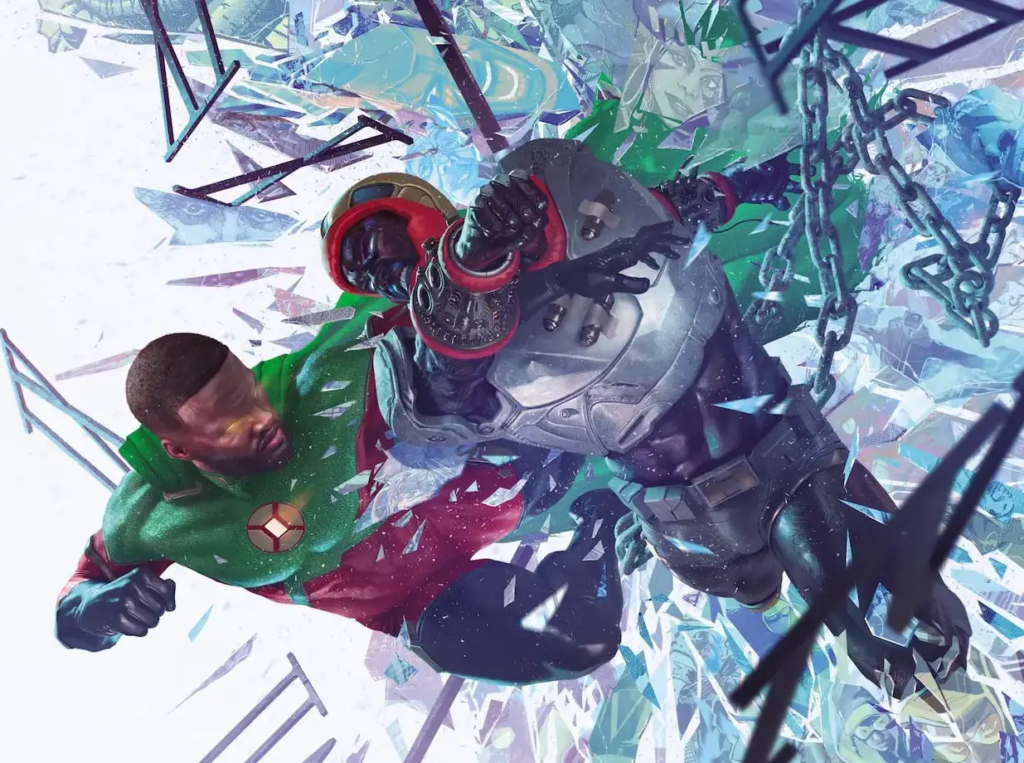‘Icon vs. Hardware’ #1 is a study in duality
Showcases the difference between its titular heroes, all the while laying the groundwork for the next stage of the Milestone Universe.
Collier Jennings | AIPT Comics
The Milestone Universe has had a resurgence over the last few years thanks to DC launching a new initiative for the characters. Said initiative has brought in a mix of Milestone founders and new creative talent, and seen the characters updated for the modern day. And now, Icon vs. Hardware #1 seeks to shake up the world of Milestone yet again – in more ways than one.
Icon vs. Hardware builds off of the events of Icon and Rocket: Season One and Hardware: Season One, as Augustus Freeman/Icon attempts to mold his protege Rocket into the leader the future needs. Meanwhile, Curtis Metcalf – aka the armored hero Hardware – remains suspicious of Icon and decides to investigate his alien tech. This leads him to make a drastic decision that not only alters his fate, but that of the entire universe – and puts him on a collision course with Icon!
Though this is billed as a “versus” book, it doesn’t have the two heroes interacting until the very end of the book. But that’s less of a bug and more of a feature, as returning Icon and Rocket writers Reginald Hudlin and Leon Chills choose to show how the two differ in their approach to superheroics. Icon is more methodical, seeing things long term. Hardware, on the other hand, lives in the now and is concerned with his own welfare. It’s a great way of pitting the two against each other without resorting to fisticuffs first.
The book also delves into time travel, which has been a bit of a double-edged sword. Most of the time, it’s used to set up alternate universes or storylines that rarely have a lasting impact. But here, all the rules are thrown out the window. We have a time traveler in Hardware who’s willing to change the past to suit his own needs, and the implications toward the end are massive. Considering this is launching a major Milestone-focused storyline named “Worlds Collide”, it should be fun to see how far those implications reach.
Continuing the theme of duality, the book is evenly split between art from Denys Cowan and Yasmin Florez Montanez, with inks from John Floyd and John Stanisci. And the artists’ style once again reflects how different both heroes are. Montanez’s work has a sleek sheen to it, bringing an animated flair to moments like Rocket standing up for a classmate or Icon soaring through the air. Cowan’s art is more rugged and hard edged, giving weight to Hardware’s armor. Colorist Chris Sotomayor also plays on this duality, shifting to brighter colors for the Icon sections and darker hues for Hardware. So does letterer Andworld Design; Rocket’s narration is depicted in captions that look like scraps of notebook paper while Hardware sticks to black and red captions.
The only obstacle the book faces is that it builds upon the events of Icon and Rocket: Season One and Hardware: Season One. So if you haven’t read those books, you may be lost. It’s a far cry from Static: Shadows of Dakota, which was able to ease in new viewers. And while this isn’t a total deal breaker – in fact, it should encourage readers to check those stories out – it does present a bit of a roadblock for some.
Icon vs. Hardware showcases the difference between its titular heroes, all the while laying the groundwork for the next stage of the Milestone Universe. The final page teases a showdown for the ages, and I’m more than looking forward to it. B


